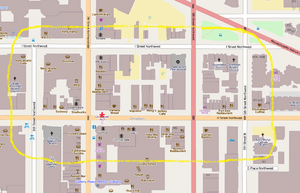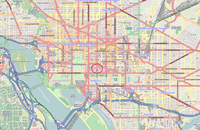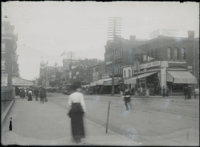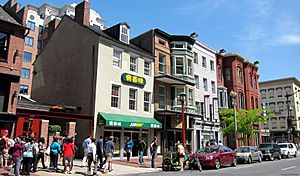Chinatown (Washington, D.C facts for kids
Quick facts for kids
Chinatown
Downtown Historic District
|
|
|---|---|
|
Neighborhood of Washington, D.C.
|
|
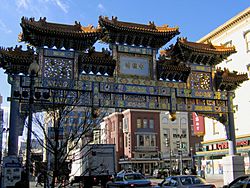
Chinatown's "Friendship Archway", as seen looking west on H Street, NW
|
|
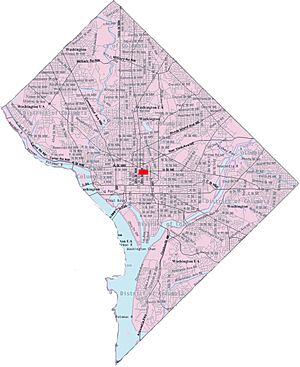
Chinatown within the District of Columbia
|
|
| Country | United States |
| District | Washington, D.C. |
| Ward | Ward 2 |
| ZIP Code |
20001
|
| Area code(s) | 202 |
Chinatown in Washington, D.C. (called Huáfǔ Huábù in Chinese), is a small, historic neighborhood. It is located east of downtown Washington, D.C. You can find about 20 Chinese and other Asian restaurants and small shops here. These are mostly along H and I Streets, between 5th and 8th Streets, Northwest.
Chinatown is famous for its yearly Chinese New Year festival and parade. It also has the beautiful Friendship Arch, a large Chinese gate over H Street at 7th Street. Nearby, you'll find the Verizon Center, a big sports and entertainment arena. The Old Patent Office Building, which holds two Smithsonian Museums, is also close by. You can easily get to Chinatown using the Washington Metro at the Gallery Place-Chinatown station.
Contents
History of Chinatown
The Chinatown area was once home to many Chinese immigrants. These immigrants started moving here in the 1930s. They had to leave Washington's first Chinatown, which was along Pennsylvania Avenue. This was because new government buildings were being built there.
The new residents added special touches to their neighborhood. They put up decorative metal designs and Chinese signs. At its busiest, Chinatown stretched from G Street north to Massachusetts Avenue. It also went from 9th Street east to 5th Street.
The Friendship Archway
In 1986, the city built the Friendship Archway. This is a traditional Chinese gate designed by Alfred H. Liu. He was a local architect and leader of the Chinatown Development Corporation. He had moved from Taiwan to the United States as a teenager.
This colorful piece of public art cost US$1 million. It has seven roofs that are up to 60 feet high. It also features 7,000 tiles and 272 painted dragons. These dragons are in the style of the ancient Ming and Qing dynasties. The arch was built to celebrate friendship with Washington's sister city, Beijing, China. People hoped it would help keep the neighborhood's Chinese feel strong. A plaque next to the arch says it is the largest single-span archway of its kind in the world. In 1993, the Friendship Archway was repaired and repainted by skilled workers from China.
Modern Changes
Also in 1986, the Metro station was renamed Gallery Place-Chinatown. In 1982, the city built the Wah Luck House apartments at 6th and H Streets, NW. These apartments were for people who had to move from other areas. Architect Alfred Liu designed this building with modern Chinese styles, like red-paneled balconies.
The Verizon Center (first called MCI Center) was finished in 1997. It was renamed Verizon Center in 2006. After this arena was built, the neighborhood became a busy place for nightlife, shopping, and fun.
Suburban Chinatowns
After some difficult times in 1968, Chinatown faced challenges. Many Chinese residents, along with others, moved to suburban areas. They went to places in Maryland and Virginia.
Where Chinese Americans Live Now
In 2010, the area that includes Chinatown had about 3,000 residents. Only about 21% of them were Asian. This is a big change from 1990, when most people living there were Chinese American (66%). About half of Chinatown's current residents live in the Wah Luck House apartments.
Washington, D.C.'s Chinatown is smaller compared to other famous Chinatowns in the U.S. For example, the Chinatowns in San Francisco and Manhattan are much larger. The closest Chinese supermarket, Great Wall Supermarket, is about 14 miles away in Falls Church, Virginia.
After the difficult times in 1968, many Chinese people looked for safer places with more economic opportunities. They moved out of Washington, D.C.'s Chinatown. They settled in suburban neighborhoods in Fairfax County, Virginia, and Montgomery County, Maryland. For example, North Potomac, Maryland, has the highest percentage of Chinese Americans in the Washington area (18.4%). The city of Rockville also has many residents of Chinese descent (eight percent). In Virginia, you can find sizable Chinese American communities in Centreville, Chantilly, and Floris.
Businesses and Fun
With the building of the Verizon Center, many old buildings, especially on 7th Street, were updated. Now, they house well-known shops and restaurants. A large new building with offices, homes, and shops was also built at 7th and H streets. These new places include restaurants, stores, a movie theater, and a bowling alley. Together with the Verizon Center, they have made the area a lively spot for evening fun, shopping, and entertainment.
It's interesting that many businesses here are not Chinese. But because of a city rule, even big chains like Starbucks, Ruby Tuesday, Ann Taylor, and Bed Bath and Beyond have their names in Chinese characters outside their stores. Chinatown has also become a home for many growing technology companies. The Washington branch of the Goethe-Institut (a German cultural center) is also located here.
Restaurants and Culture
Chinatown's most well-known businesses are its about 20 Chinese and Asian restaurants. Most of these are owned by Asian American families. Some popular ones include Chinatown Express, Eat First, Full Kee, and Tony Cheng's. One restaurant, Wok & Roll, is in a building that was once Mary Surratt's boarding house. This was a meeting place for John Wilkes Booth and his friends involved in Abraham Lincoln's assassination. Another restaurant is in a house once owned by the On Leong Chinese Merchants Association. This was one of the first Chinese groups to move into the neighborhood. Today, this building is a historic landmark.
The neighborhood also has a Chinese video store, several general stores, and many Chinese American cultural and religious groups. Chinatown has one Chinese church, Chinese Community Church, at 500 I Street. It was started in 1935 and moved to its current spot in 2006. The historic synagogue at 6th and I streets has been restored and hosts cultural events.
Getting Around
The Washington Metro station, Gallery Place, opened in 1976 and serves the neighborhood. Two important Metrobus routes also cross at 7th and H Streets, making it easy to get around.
Images for kids


